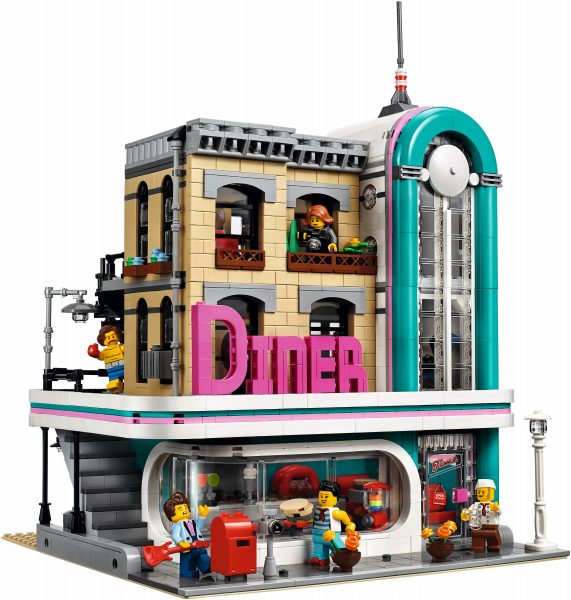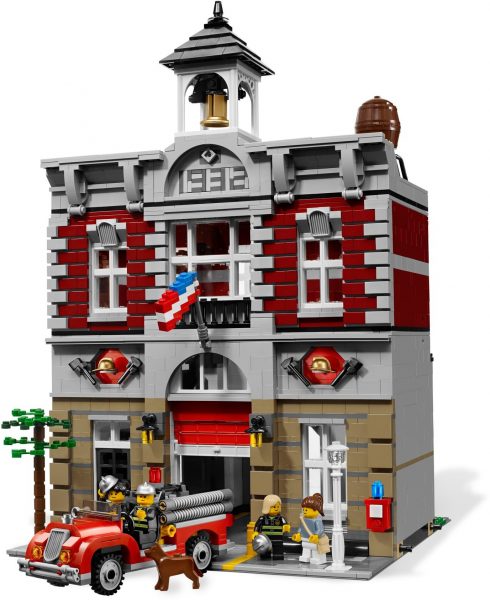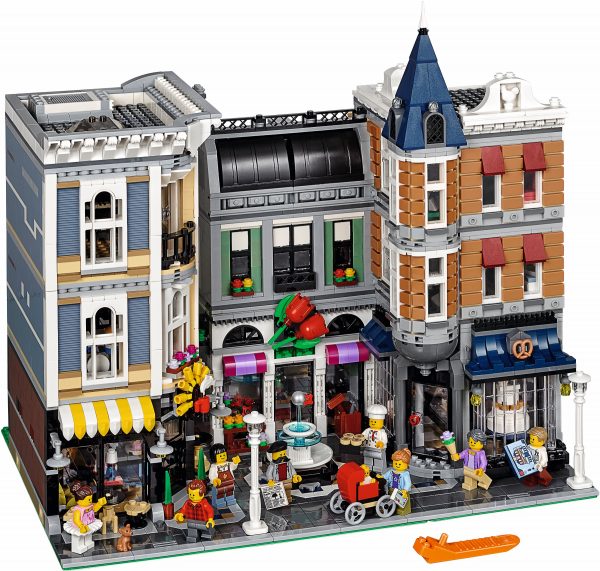Interview: Modular Building Series with Jamie Berard
In the second half of Brick Architect’s interview with Creator Expert designer Jamie Berard, we’re focusing on 10 years of the Modular Building series. I learned a lot during our interview, and think you will find it interesting too!
This interview took place on May 31, 2018 at the LEGO Idea House. The interview has been broken into two parts—be sure to also check out the first part of our interview where we explored the Creator Expert series as a whole.
10 years of the Modular Building Series
Brick Architect: Let’s talk about #10260 Downtown Diner, which is the latest addition to the Modular Building Series. A lot people seem to love it in isolation, but say it looks too different when they put it next to the rest of the modulars. How you feel about this slightly new direction the series has taken?
Jamie Berard: I think this is a very deliberate move. Coming off the 10th anniversary, we had 12 modular buildings of a fairly consistent style. Some people would say there are two stages of the modular, with #10243 Parisian Restaurant starting the second expression because we put more detail inside the building and focused a bit more on storytelling. As we approached the 10 year mark, we needed to be careful that we didn’t stay on auto-pilot, where it becomes too familiar and people can just predict the next one.
We worked quite hard to make sure the diner fit in with the rest of the street. It’s almost like the tan building was there all along and then this new diner opened up wanted to make a splash; I’ve seen buildings like that. They literally wrap a building with the new hotness, but you still see the old brick building behind it.
Our thought is keep it tied to older colors and styles, not like everything after this is going to be in crazy Friends colors (I shouldn’t say friends colors.) It’s not that we are taking a radically different direction, we just wanted to show that we can do something fresh and hopefully retain it.
Brick Architect: Did the research and design for the Downtown Diner correlate with the internal reset at LEGO, and the shift to a more agile design methodology.
Jamie Berard: No, I wouldn’t say so myself—this was all our own doing. Of course we are influenced by what’s happening, but for any product line to go more than a few years (3 years max), before they have to shake something up is rare. For us, it’s been an amazing 10 year journey.
Keeping things fresh
What’s funny is that #10197 Fire Brigade is one of the buildings that brought in the most new people into the line, and if you talk to most LEGO fans if they have been around awhile, most of them started with the Fire Brigade. If I just listened to what everyone was saying, I would have thought it was the worst thing we created and ruined the entire line. Yet, with historic context I’m realizing that people just get comfortable with what they think is coming, and it’s uncomfortable to experience something new, and their first reaction is to explain what it should have been. When you give them a bit of time, many will come around to appreciate what they can discover later, and something like Fire Brigade can become one of our most successful ones, even though on paper it was the one that was going to ruin everything.
Storytelling in the Modular Building Series
Brick Architect: So many people love the Modular Building series for the narrative opportunities. The series is great for where one person can build and everyone plays. In your designer videos it is clear that you are most excited about are the stories inside. For the modular buildings, do you design the model first, or storyboard the narrative elements first?
Jamie Berard: I think there are some characters, some stories that we just want to fit, so for #10255 Assembly Square, for years we had this mapping based around stories or architectural styles, so I’ll say it will be this type of architecture and it is a bakery. (I need to bluff my way through architecture nomenclature; Rok typically gets what I’m saying, but tells me to stop because it hurts to hear me describe it so poorly.)
So for something like that we said, wouldn’t it be fun to have a dentist above a candy shop, so that was the pitch. It was supposed to be a candy shop on the ground floor, but it ended up the candy shop evolved to a bakery with sweet type pastries instead of breads.
We also had stories where we had created romances up front between two characters, and everything else flowed from that. While Assembly square started story first but other instances started with the buildings. For Downtown Diner we had the diner, and I knew we wanted a boxing ring in the middle floor, and with that we had a boxer. We didn’t have all the characters, so we created this music story going on downstairs but hadn’t really thought through the relationship between everything. Then we started to fill in the blanks… the boxer needs to go downstairs to eat to get powered up for the gym, and the singer shows up, like in a 1950’s film where a guy just comes in and just starts doing this dance thing. So, they go back and forth.
Brick Architect: I really liked the money laundering in #10251 Brick Bank–It’s almost like you are sneaking in somewhat subversive narratives just for adults.
Jamie Berard: It’s just the naivete that you can get away with in the system, but I think that is a good example where it was clearly the story that drove the style of the building, and what’s funnier than literally having a laundromat with the money washer.
We also like to say when we are talking about characters that we like to flip stereotypical roles in many ways, like the engineer driving the Horizon Express train was a female, and we try to use non-conventional roles – the diversity of life and we can do that easier than with other lines…
When you go to kids testing, the boys want to become the character and it is really hard for a 5 year old boy to become Lady Jane. He wants to be Spiderman so he can help her. It’s harder for them to imagine becoming a woman. But with the modulars, we don’t have to worry about this.
Brick Architect: The modulars are more like a sitcom and less a narrative involving yourself.
Jamie Berard: Exactly. To appreciate the full scene, you need the whole set of characters as they can interact together. Especially when we did the two dots and a smiley face we could be more ambiguous; maybe it’s a guy and maybe it’s a woman, and that’s great. We actually had a lot of fun in the early days especially with the ambiguity you can create with a neutral face and the stocky torso. And even with the move to expressive faces, we want to make sure we are representing a broad arrangement of people – Life is diverse and it is fun that we can go after some unique, quirky characters like the boxer with his flamboyant hair, a strong guy with poofy hair who walks by a mirror and is like, “hey, beautiful”.
Brick Architect: While the story for each model is rich, I’ve wondered if there is a larger story across the models: is it all one city or are they only connected by the universal pin design?
Jamie Berard: This is not written down or anything but I think they are. In my opinion, it is in the first half of the last century, this separates it from what people know today. Whenever it is not your reality you can take the best of it, you can imagine it in a fantasy-like way. So it would be a bit of a shame if we went today, you would have all these preconceived notions about things about what you know today, good and bad.
Part of the charm is that it is a made up street in another time, similar to the Winter Village series. A world that you can escape to where people are just deliriously naïve. We have a little bit of fun; when the minfigs are smuggling something, it is cookies – that also happened because we had a sugar ban at work, where you weren’t allowed to have sugary beverages and treats, but they are looser about it now. That was our reaction to that; it has to come through somehow.
In my mind, it makes sense they belong together, but should be anywhere in the world. I actually remember when the #10182 Café Corner came out and people were sending me images from different places people thought were the reference: one was in Louisiana, one was in Boston, and one was in Paris, of course. And they all looked pretty close. That’s the nice thing, if you go to any of the major cities you are going to see a mash-up of Tudor next to Victorian next to Art Deco, or whatever was available at the time, and it’s great… That’s what makes cities fun.
LEGO Color Palette
Brick Architect: Were you involved in bringing Teal back?
Brick Architect: Was the set partly along in the design process when the color conversation started.
Jamie Berard: Since it wasn’t a sure thing that it was happening, we had backup colors we could use. It wasn’t critical to our model, but we thought that it was appropriate if we could use it as much as possible.
Brick Architect: What other colors were you considering?
Jamie Berard: We considered 322Medium AzurMedium Azure and some other blues. All of these complement the 322Bright PurpleDark Pink color we wanted to use for the convertible in this set. That got us thinking that would be a nice hot line on the sign, and the blues offset it nicely. In the end, we thought this set was a nice way to bring teal back, and bring it back with a quantity of bricks. The worst thing is if we only give you you one or two of an element; that’s not very useful.
Favorite Sets
Brick Architect: I’d love to hear about your favorite set.
#10255 Assembly Square is probably the one that I am most proud of, since so much of the team is in that one. It was a team celebration, because I had so many people contributing to the interiors, just dropping things off at my desk. One day a dentist’s chair was there, the next day a baker’s rack. And it just came together like we were one extension of the same person, and I love that I got the best out of all of my colleagues and they are all in there in something that I think is quite nice.







Now that the Bookstore is official and we’ve had Wes Talbot in the designer video, I am almost certain that is who Jamie refers to when he mentions bringing teal back. I would also love to hear more details about the color being “killed off” in the first place, probably a result of the restructure?
Awesome interviews – thank you!
I’m glad to read that Lego tries to be responsive to at least some of the feedback from AFOLs about the Modular line. I’m personally an “exteriors over interiors” fan any day (since I rarely see the interiors once they’re sitting on a shelf), but I appreciate that the interior designs really appeal to a lot of fans. More functional issues like interior spaces being too small for adult hands are definitely something that warrants Lego’s consideration.
Very interesting article and interview. It’s somehow rare to come so deep in the creating and designing process. It’s also true that if the people don’t like change or mutation, they are also able to quickly change their mind and appreciate what’s new and good and that seemed to be a wrong thing at the beginning. So I am glad to learn that if the designers take in consideration the comments and feedbacks of the AFOL community, they also have experience enough to “filter” it. And as it is probably something hard to do (going on ignoring some people saying your work is poor or wrong) designing such expected sets as Modulars must be something hard but also so pleasing and full of great satisfaction. Because it’s true that a set is always, always better once “in flesh” in front of you than you could imagine from pictures or other’s reviews, and while building a new lego set, there are always unexpected things to do and good surprises. This is what I like with building processes. And even if I don’t buy Modulars (I would for sure purchase them all if I could, but collecting SW I can’t afford all the ranges I would like to) I am always delighted with each new release. Very good interview, with clever questions, and clever answers. Thanks for sharing your experiences.
Great to learn about the inspiration for Parisian Restaurant.